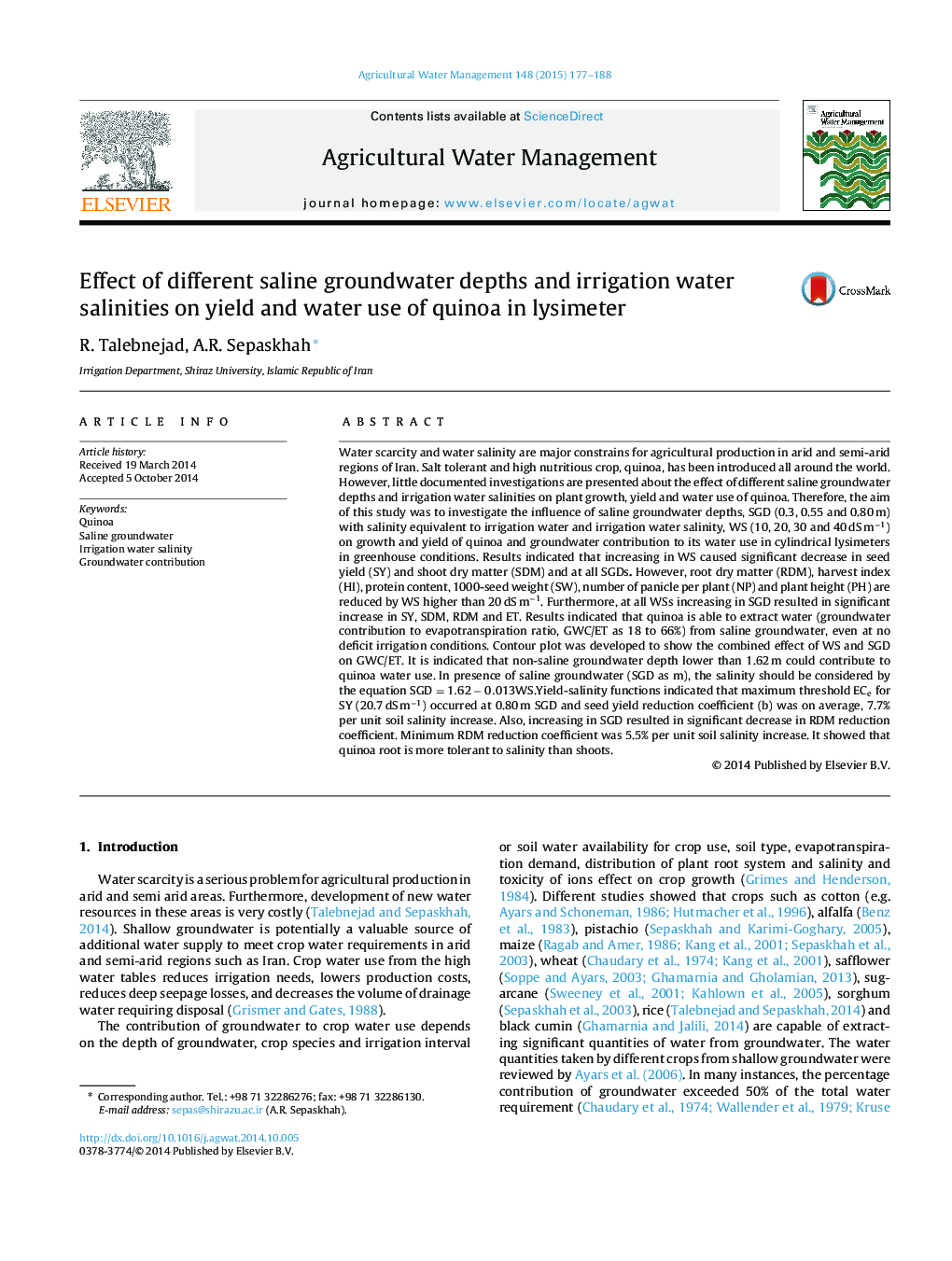| کد مقاله | کد نشریه | سال انتشار | مقاله انگلیسی | نسخه تمام متن |
|---|---|---|---|---|
| 6363822 | 1622931 | 2015 | 12 صفحه PDF | دانلود رایگان |
عنوان انگلیسی مقاله ISI
Effect of different saline groundwater depths and irrigation water salinities on yield and water use of quinoa in lysimeter
ترجمه فارسی عنوان
تاثیر عمق آب زیرزمینی مختلف شوری و شوری آب آبیاری بر عملکرد و مصرف آب چینو در لیزیومتر
دانلود مقاله + سفارش ترجمه
دانلود مقاله ISI انگلیسی
رایگان برای ایرانیان
کلمات کلیدی
کوینو، آب های زیرزمینی سالین، شوری آب آبیاری، مشارکت آبهای زیرزمینی،
موضوعات مرتبط
علوم زیستی و بیوفناوری
علوم کشاورزی و بیولوژیک
علوم زراعت و اصلاح نباتات
چکیده انگلیسی
Water scarcity and water salinity are major constrains for agricultural production in arid and semi-arid regions of Iran. Salt tolerant and high nutritious crop, quinoa, has been introduced all around the world. However, little documented investigations are presented about the effect of different saline groundwater depths and irrigation water salinities on plant growth, yield and water use of quinoa. Therefore, the aim of this study was to investigate the influence of saline groundwater depths, SGD (0.3, 0.55 and 0.80Â m) with salinity equivalent to irrigation water and irrigation water salinity, WS (10, 20, 30 and 40Â dSÂ mâ1) on growth and yield of quinoa and groundwater contribution to its water use in cylindrical lysimeters in greenhouse conditions. Results indicated that increasing in WS caused significant decrease in seed yield (SY) and shoot dry matter (SDM) and at all SGDs. However, root dry matter (RDM), harvest index (HI), protein content, 1000-seed weight (SW), number of panicle per plant (NP) and plant height (PH) are reduced by WS higher than 20Â dSÂ mâ1. Furthermore, at all WSs increasing in SGD resulted in significant increase in SY, SDM, RDM and ET. Results indicated that quinoa is able to extract water (groundwater contribution to evapotranspiration ratio, GWC/ET as 18 to 66%) from saline groundwater, even at no deficit irrigation conditions. Contour plot was developed to show the combined effect of WS and SGD on GWC/ET. It is indicated that non-saline groundwater depth lower than 1.62Â m could contribute to quinoa water use. In presence of saline groundwater (SGD as m), the salinity should be considered by the equation SGD=1.62â0.013WS.Yield-salinity functions indicated that maximum threshold ECe for SY (20.7Â dSÂ mâ1) occurred at 0.80Â m SGD and seed yield reduction coefficient (b) was on average, 7.7% per unit soil salinity increase. Also, increasing in SGD resulted in significant decrease in RDM reduction coefficient. Minimum RDM reduction coefficient was 5.5% per unit soil salinity increase. It showed that quinoa root is more tolerant to salinity than shoots.
ناشر
Database: Elsevier - ScienceDirect (ساینس دایرکت)
Journal: Agricultural Water Management - Volume 148, 31 January 2015, Pages 177-188
Journal: Agricultural Water Management - Volume 148, 31 January 2015, Pages 177-188
نویسندگان
R. Talebnejad, A.R. Sepaskhah,
